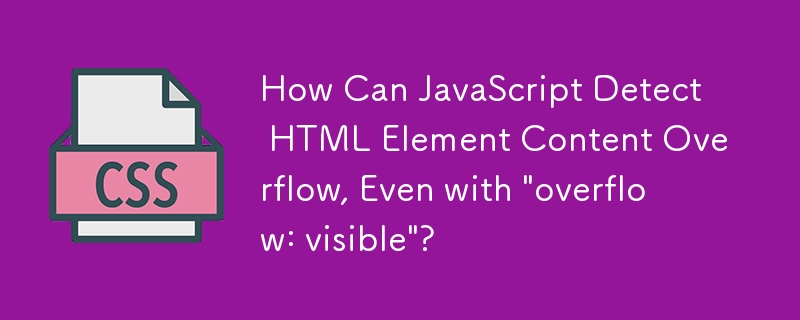 Web Front-end
Web Front-end
 CSS Tutorial
CSS Tutorial
 How Can JavaScript Detect HTML Element Content Overflow, Even with 'overflow: visible'?
How Can JavaScript Detect HTML Element Content Overflow, Even with 'overflow: visible'?
How Can JavaScript Detect HTML Element Content Overflow, Even with 'overflow: visible'?

How to Detect Content Overflow in HTML Elements Using JavaScript
Determining whether an HTML element's content is overflowing its boundaries can be crucial for maintaining user experience and ensuring proper visual representation. While overflow is typically detected by comparing the element's client dimensions (height and width) with its scroll dimensions, conventional methods fall short when the overflow property is set to "visible."
To overcome this challenge, a more comprehensive detection approach is required. The following JavaScript function addresses this issue:
// Determines if the passed element is overflowing its bounds,
// either vertically or horizontally.
// Will temporarily modify the "overflow" style to detect this
// if necessary.
function checkOverflow(el)
{
var curOverflow = el.style.overflow;
if ( !curOverflow || curOverflow === "visible" )
el.style.overflow = "hidden";
var isOverflowing = el.clientWidth < el.scrollWidth
|| el.clientHeight < el.scrollHeight;
el.style.overflow = curOverflow;
return isOverflowing;
}This function meticulously examines an element and adjusts its "overflow" style to "hidden" if necessary. Subsequently, it compares the element's client dimensions with its scroll dimensions. If any of these dimensions are smaller than their corresponding scroll dimensions, the function concludes that the element's content is overflowing.
The function's integrity has been validated across multiple browsers, including Firefox 3 and 40, Internet Explorer 6, and Chrome 0.2.149.30. By incorporating this robust approach into your JavaScript repertoire, you can confidently identify elements with overflowing content, enabling you to resolve display issues and enhance the user experience of your web applications.
The above is the detailed content of How Can JavaScript Detect HTML Element Content Overflow, Even with 'overflow: visible'?. For more information, please follow other related articles on the PHP Chinese website!

Hot AI Tools

Undresser.AI Undress
AI-powered app for creating realistic nude photos

AI Clothes Remover
Online AI tool for removing clothes from photos.

Undress AI Tool
Undress images for free

Clothoff.io
AI clothes remover

Video Face Swap
Swap faces in any video effortlessly with our completely free AI face swap tool!

Hot Article

Hot Tools

Notepad++7.3.1
Easy-to-use and free code editor

SublimeText3 Chinese version
Chinese version, very easy to use

Zend Studio 13.0.1
Powerful PHP integrated development environment

Dreamweaver CS6
Visual web development tools

SublimeText3 Mac version
God-level code editing software (SublimeText3)

Hot Topics
 Vue 3
Apr 02, 2025 pm 06:32 PM
Vue 3
Apr 02, 2025 pm 06:32 PM
It's out! Congrats to the Vue team for getting it done, I know it was a massive effort and a long time coming. All new docs, as well.
 Can you get valid CSS property values from the browser?
Apr 02, 2025 pm 06:17 PM
Can you get valid CSS property values from the browser?
Apr 02, 2025 pm 06:17 PM
I had someone write in with this very legit question. Lea just blogged about how you can get valid CSS properties themselves from the browser. That's like this.
 A bit on ci/cd
Apr 02, 2025 pm 06:21 PM
A bit on ci/cd
Apr 02, 2025 pm 06:21 PM
I'd say "website" fits better than "mobile app" but I like this framing from Max Lynch:
 Stacked Cards with Sticky Positioning and a Dash of Sass
Apr 03, 2025 am 10:30 AM
Stacked Cards with Sticky Positioning and a Dash of Sass
Apr 03, 2025 am 10:30 AM
The other day, I spotted this particularly lovely bit from Corey Ginnivan’s website where a collection of cards stack on top of one another as you scroll.
 Using Markdown and Localization in the WordPress Block Editor
Apr 02, 2025 am 04:27 AM
Using Markdown and Localization in the WordPress Block Editor
Apr 02, 2025 am 04:27 AM
If we need to show documentation to the user directly in the WordPress editor, what is the best way to do it?
 Comparing Browsers for Responsive Design
Apr 02, 2025 pm 06:25 PM
Comparing Browsers for Responsive Design
Apr 02, 2025 pm 06:25 PM
There are a number of these desktop apps where the goal is showing your site at different dimensions all at the same time. So you can, for example, be writing
 How to Use CSS Grid for Sticky Headers and Footers
Apr 02, 2025 pm 06:29 PM
How to Use CSS Grid for Sticky Headers and Footers
Apr 02, 2025 pm 06:29 PM
CSS Grid is a collection of properties designed to make layout easier than it’s ever been. Like anything, there's a bit of a learning curve, but Grid is
 Why are the purple slashed areas in the Flex layout mistakenly considered 'overflow space'?
Apr 05, 2025 pm 05:51 PM
Why are the purple slashed areas in the Flex layout mistakenly considered 'overflow space'?
Apr 05, 2025 pm 05:51 PM
Questions about purple slash areas in Flex layouts When using Flex layouts, you may encounter some confusing phenomena, such as in the developer tools (d...





